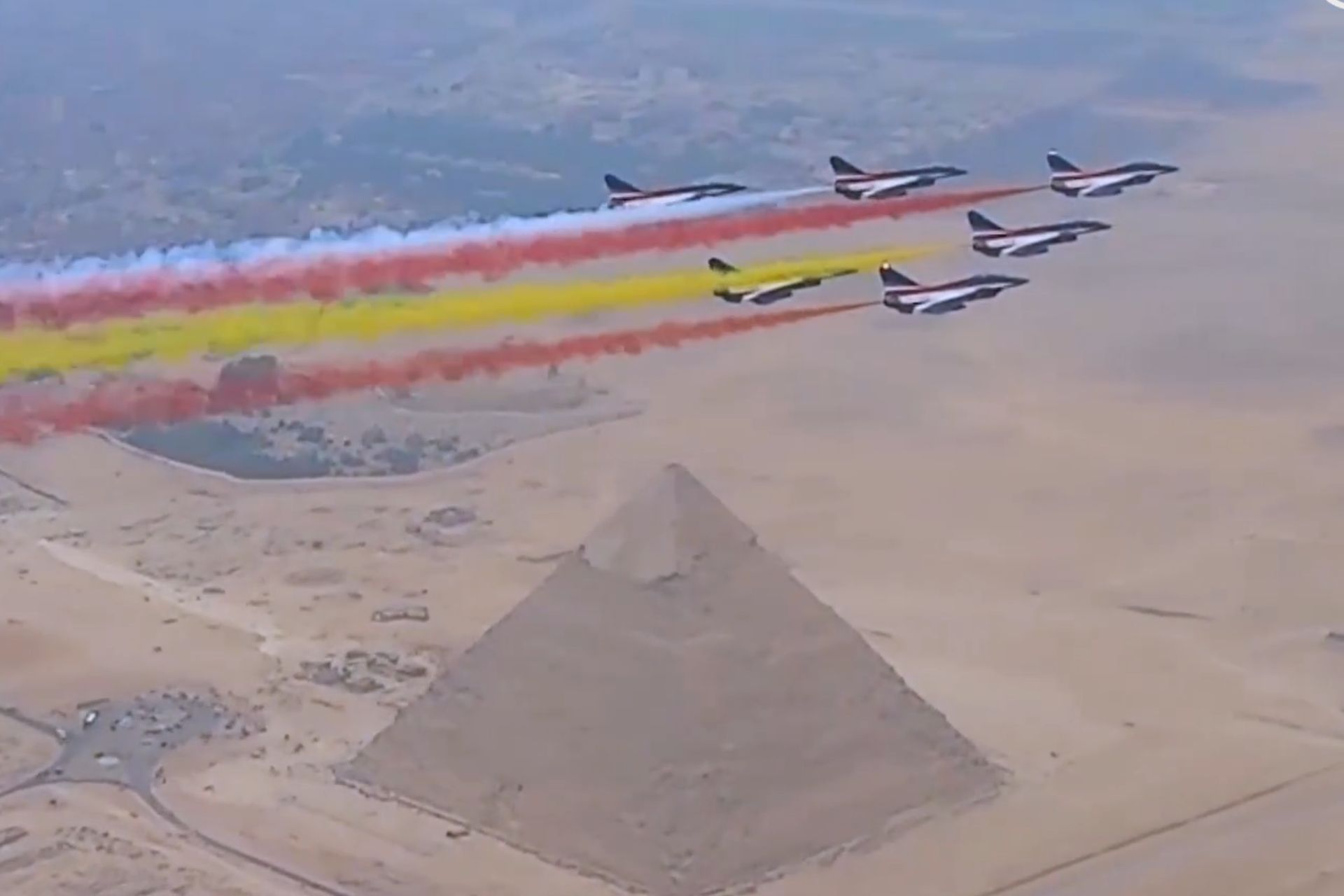Egypt Officializes Its Choice of Chinese J-10C Fighters to Replace American F-16s

{loadposition bannertop}
{loadposition sidebarpub}
Egypt has officially announced that it will replace its aging fleet of American F-16s with Chinese J-10C Vigorous Dragon fighters, following discussions over the past few months. This decision made public during the first Egypt International Air Show, reflects Cairo’s intent to diversify its military equipment sources, thus reducing its reliance on U.S. defense systems.Follow Army Recognition on Google News at this link
This decision comes during a time of geopolitical realignment for Egypt, which recently joined the BRICS bloc alongside major players such as China, Russia, and India. (Picture source: PLA Air Force)
The Chengdu J-10C, in service with the Chinese Air Force (PLAAF) since 2004, is a multirole fighter equipped with a single engine, delta wings, and a canard configuration. Known for its maneuverability and versatility, the J-10C offers advanced capabilities at a competitive cost, making it an attractive alternative to the American F-16V, which had been proposed as an upgrade for the Egyptian fleet.Developed by Chengdu Aircraft Industry Corporation (CAC), the J-10C features advanced electronic warfare systems and an active electronically scanned array (AESA) radar. It supports multirole operations with targeting pods, laser-guided bombs, and air-to-air missiles. Officially entering service in December 2017, the J-10C is currently operated by China and Pakistan, and Egypt has expressed interest in acquiring a dozen units, primarily due to its lower cost compared to Western and Russian fighter jets.The J-10C is designed with a “tailless delta-canard” aerodynamic layout, which improves its maneuverability and overall lift. It is powered by a Russian Lyulka-Saturn AL-31FN turbofan engine, capable of reaching a maximum speed of 2,200 km/h and a range of 3,200 km. Additionally, it is equipped with modern avionics, including an IRST sensor and various externally-mounted avionics pods for navigation, targeting, and electronic reconnaissance missions.This decision comes during a time of geopolitical realignment for Egypt, which recently joined the BRICS bloc alongside major players such as China, Russia, and India. In recent years, Egypt has also acquired defense equipment from Russia and France, including the MiG-29M and Dassault Rafale. The Chinese J-10C is set to become a key part of Egypt’s diversified arsenal.This development also reflects the growing economic and strategic ties between Egypt and China. China’s participation in the Egypt Air Show in El Alamein is part of its broader effort to strengthen its presence in the Middle East and North Africa. China’s military-industrial influence in the region has significantly expanded, supported by its growing economic relationships, particularly through energy imports.
A Yun-20 and a J-10 fighter aircraft from the Chinese Air Force flew over the Pyramids during the 2024 Egypt International Air Show. (Picture source: PLA Air Force)
Despite adopting Chinese fighters, Egypt continues to maintain defense relations with the United States, as evidenced by a recent agreement to acquire two C-130J Hercules transport aircraft through the U.S. Foreign Military Sales (FMS) program. However, the transition to the J-10C represents a significant shift, as Egypt’s American F-16s, which have formed the backbone of the Egyptian Air Force since the 1980s, are now considered outdated in the face of modern air defense systems.Several factors likely influenced Egypt’s decision, including the J-10C’s cost-effectiveness and its advanced combat capabilities. Additionally, Egypt’s concerns regarding U.S. policy in the region, particularly its support for Israeli operations in Gaza, may have played a role in the shift towards Chinese defense technology.With this acquisition, Egypt becomes the second country after Pakistan to operate the J-10C Vigorous Dragon. The Egyptian Air Force is expected to deploy these fighters to enhance its operational capabilities in North Africa and the Middle East, solidifying Egypt’s position as a regional military power.Egypt’s interest in Chinese fighters extends beyond the J-10C, with the country also showing interest in the J-31, a fifth-generation stealth fighter. While the J-10C offers multirole capabilities at a reduced cost, making it competitive with Western and Russian aircraft, the J-31 is seen as a strategic asset to counter Israeli F-35s. The J-31’s advanced stealth features, radar evasion capabilities, and modern weapon systems make it a serious candidate for modernizing Egypt’s air capabilities and maintaining a balance of power in the region. Its ability to perform bombing, interdiction, and close air support missions further reinforces Egypt’s interest, particularly in a geopolitical context where it seeks to diversify its defense sources in response to sanctions on Russia and the U.S.-Israel relationship.The Egyptian Air Force (EAF) plays a central role in the country’s defense strategy, with a diversified fleet of fighter jets from various sources. Egypt currently operates American F-16s, Russian MiG-29s, and French Rafales, reflecting its military diversification strategy. However, many of these aircraft, particularly the F-16s, are considered aging and less effective against modern threats. Egypt’s desire to acquire J-10Cs and J-31s demonstrates its commitment to strengthening its air fleet in the face of new regional challenges, including Israeli air superiority.The defense partnership between China and Egypt has a long history, dating back to the 1970s. Over the decades, this partnership has grown stronger with the supply of various Chinese military equipment, including submarines, destroyers, missile boats, and aircraft. China’s non-interference policy and its strategic approach to arms exports, free from political conditions, make this cooperation particularly attractive to Egypt. Additionally, China offers competitive pricing and advanced technology transfers, facilitating joint production projects. This enables Egypt to continuously modernize its armed forces while diversifying its international partnerships in an ever-evolving geopolitical landscape.

{loadposition bannertop}
{loadposition sidebarpub}
Egypt has officially announced that it will replace its aging fleet of American F-16s with Chinese J-10C Vigorous Dragon fighters, following discussions over the past few months. This decision made public during the first Egypt International Air Show, reflects Cairo’s intent to diversify its military equipment sources, thus reducing its reliance on U.S. defense systems.
Follow Army Recognition on Google News at this link
This decision comes during a time of geopolitical realignment for Egypt, which recently joined the BRICS bloc alongside major players such as China, Russia, and India. (Picture source: PLA Air Force)
The Chengdu J-10C, in service with the Chinese Air Force (PLAAF) since 2004, is a multirole fighter equipped with a single engine, delta wings, and a canard configuration. Known for its maneuverability and versatility, the J-10C offers advanced capabilities at a competitive cost, making it an attractive alternative to the American F-16V, which had been proposed as an upgrade for the Egyptian fleet.
Developed by Chengdu Aircraft Industry Corporation (CAC), the J-10C features advanced electronic warfare systems and an active electronically scanned array (AESA) radar. It supports multirole operations with targeting pods, laser-guided bombs, and air-to-air missiles. Officially entering service in December 2017, the J-10C is currently operated by China and Pakistan, and Egypt has expressed interest in acquiring a dozen units, primarily due to its lower cost compared to Western and Russian fighter jets.
The J-10C is designed with a “tailless delta-canard” aerodynamic layout, which improves its maneuverability and overall lift. It is powered by a Russian Lyulka-Saturn AL-31FN turbofan engine, capable of reaching a maximum speed of 2,200 km/h and a range of 3,200 km. Additionally, it is equipped with modern avionics, including an IRST sensor and various externally-mounted avionics pods for navigation, targeting, and electronic reconnaissance missions.
This decision comes during a time of geopolitical realignment for Egypt, which recently joined the BRICS bloc alongside major players such as China, Russia, and India. In recent years, Egypt has also acquired defense equipment from Russia and France, including the MiG-29M and Dassault Rafale. The Chinese J-10C is set to become a key part of Egypt’s diversified arsenal.
This development also reflects the growing economic and strategic ties between Egypt and China. China’s participation in the Egypt Air Show in El Alamein is part of its broader effort to strengthen its presence in the Middle East and North Africa. China’s military-industrial influence in the region has significantly expanded, supported by its growing economic relationships, particularly through energy imports.

A Yun-20 and a J-10 fighter aircraft from the Chinese Air Force flew over the Pyramids during the 2024 Egypt International Air Show. (Picture source: PLA Air Force)
Despite adopting Chinese fighters, Egypt continues to maintain defense relations with the United States, as evidenced by a recent agreement to acquire two C-130J Hercules transport aircraft through the U.S. Foreign Military Sales (FMS) program. However, the transition to the J-10C represents a significant shift, as Egypt’s American F-16s, which have formed the backbone of the Egyptian Air Force since the 1980s, are now considered outdated in the face of modern air defense systems.
Several factors likely influenced Egypt’s decision, including the J-10C’s cost-effectiveness and its advanced combat capabilities. Additionally, Egypt’s concerns regarding U.S. policy in the region, particularly its support for Israeli operations in Gaza, may have played a role in the shift towards Chinese defense technology.
With this acquisition, Egypt becomes the second country after Pakistan to operate the J-10C Vigorous Dragon. The Egyptian Air Force is expected to deploy these fighters to enhance its operational capabilities in North Africa and the Middle East, solidifying Egypt’s position as a regional military power.
Egypt’s interest in Chinese fighters extends beyond the J-10C, with the country also showing interest in the J-31, a fifth-generation stealth fighter. While the J-10C offers multirole capabilities at a reduced cost, making it competitive with Western and Russian aircraft, the J-31 is seen as a strategic asset to counter Israeli F-35s. The J-31’s advanced stealth features, radar evasion capabilities, and modern weapon systems make it a serious candidate for modernizing Egypt’s air capabilities and maintaining a balance of power in the region. Its ability to perform bombing, interdiction, and close air support missions further reinforces Egypt’s interest, particularly in a geopolitical context where it seeks to diversify its defense sources in response to sanctions on Russia and the U.S.-Israel relationship.
The Egyptian Air Force (EAF) plays a central role in the country’s defense strategy, with a diversified fleet of fighter jets from various sources. Egypt currently operates American F-16s, Russian MiG-29s, and French Rafales, reflecting its military diversification strategy. However, many of these aircraft, particularly the F-16s, are considered aging and less effective against modern threats. Egypt’s desire to acquire J-10Cs and J-31s demonstrates its commitment to strengthening its air fleet in the face of new regional challenges, including Israeli air superiority.
The defense partnership between China and Egypt has a long history, dating back to the 1970s. Over the decades, this partnership has grown stronger with the supply of various Chinese military equipment, including submarines, destroyers, missile boats, and aircraft. China’s non-interference policy and its strategic approach to arms exports, free from political conditions, make this cooperation particularly attractive to Egypt. Additionally, China offers competitive pricing and advanced technology transfers, facilitating joint production projects. This enables Egypt to continuously modernize its armed forces while diversifying its international partnerships in an ever-evolving geopolitical landscape.






